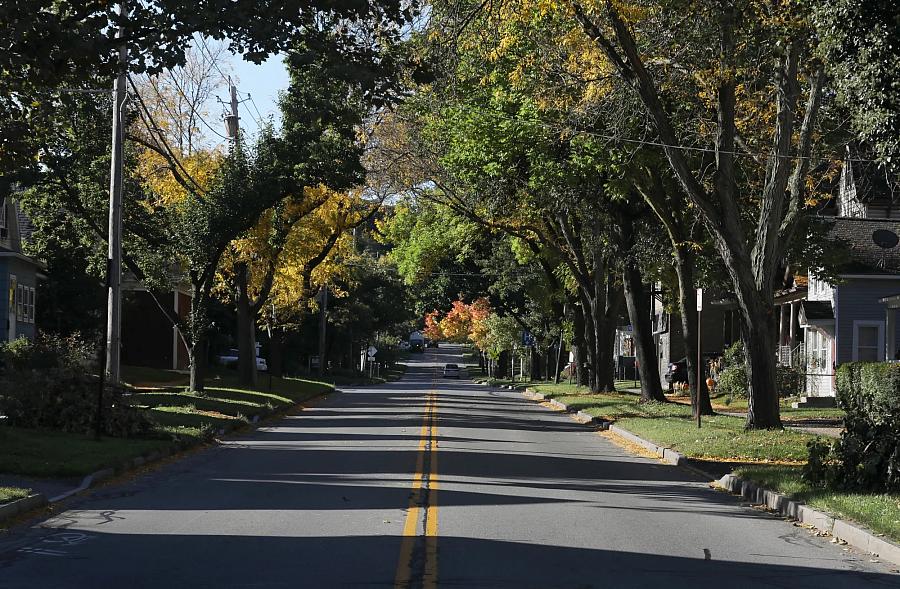A reporter’s novel analysis of ‘tree equity’ in Rochester is helping green the city’s poorer neighborhoods

Tree-lined South Goodman Street in Rochester, New York. The leafy bounty doesn't extend to the city's poorer, mostly Black and brown neighborhoods, as Justin Murphy's novel data-driven reporting for the 2021 Data Fellowship showed.
(Photo by Shawn Down/Rochester Democrat and Chronicle)
One way to tell the affluent, predominantly white areas of Rochester, New York from the poorer, mostly Black and brown neighborhoods is by the abundance and health of their trees. It’s a pattern that holds across many cities in the United States.
This disparity is about more than just aesthetics. It also has important consequences for physical and mental health, property values and quality of life in Rochester’s most disadvantaged communities, as Data Fellow Justin Murphy detailed in a data-driven series for the Rochester Democrat and Chronicle and the USA Today Network.
Murphy found that Rochester’s celebrated maple, oak and ash trees cover nearly 50% of the land in more affluent neighborhoods, but only 15% in the poorest parts of the city. As a result, the poorest neighborhoods are as much as 12 degrees hotter on a typical summer day, contributing to heat-related illnesses in neighborhoods that already have a disproportionate share of residents in poor health.
“How many trees there are in an area has an important, demonstrable effect on the health of the people living in the city,” Murphy said. “It can literally take time off people’s lives to have temperature differences like that.”
Murphy’s project, powered by the sophisticated skills and mentoring he gained as a 2021 Center for Health Journalism Data Fellow, has had a lasting impact. Following its publication in April 2022, Rochester’s newly elected mayor, Malik Evans, adopted the issue as a major focus of his administration, announcing an initiative to plant 6,000 additional trees by the end of his first term and committing $1.5 million to the effort.
Citing Murphy’s reporting, the city also applied for and won $3 million in federal funding for the tree planting initiative. By Fall 2024, the city had planted 2,000 trees and announced that its award of $3 million through the USDA Urban and Community Forestry Inflation Reduction Act would allow the city to plant another 4,000 over the following two years.
U.S. Senate Majority Leader Chuck Shumer, who represents the state, credited Murphy’s series when he came to Rochester to announce the grant.
Another result of the project was that the local Rochester teachers’ college created a semester-long science curriculum to train new science teachers based on his reporting. To Murphy, an education reporter for much of his career with the Democrat and Chronicle, that was perhaps the most personally gratifying impact of the series.
Murphy said he never would have been able to take on such an ambitious project without the training and support he received during his fellowship.
“When I set out, I didn’t have the tools to analyze the tree canopy in Rochester and then put that together with health outcomes from CDC data and create something that people would be able to use,” Murphy said. “It was through the fellowship that I was able to take these ambitious ideas and actually enact them in a way that I never would have been able to do otherwise.”
Murphy’s project was ambitious and complex, and the Center brought in two special mentors to work with him for months. The goal, as with all the journalists we partner with on data journalism: to help him learn new skills while deploying data analysis to tell an original and irrefutable data-powered story.
His project combined multiple data sets, including tree canopy maps using satellite imagery, surface temperature data from NASA, demographic data from the U.S. Census Bureau and health data from the U.S. Centers for Disease Control and Prevention.
Murphy credits the Center for bringing in an expert in mapping, Eric Sagara of Stanford University, to help him learn how to combine different data sets into a series of interactive maps that formed the basis of his project.
Murphy’s main mentor – MaryJo Webster, data editor for the Minneapolis Star Tribune – guided him through all the data elements that needed to come together for the project. Murphy learned how to write software, using the R programming language, to analyze the data. But more important was how Webster helped him to feel comfortable with a complex data project, coaching him on what to expect.
“Having someone who really understands how those stories progress and what kinds of questions to ask of your data, of yourself and of your sources, that was really indispensable,” he said.
